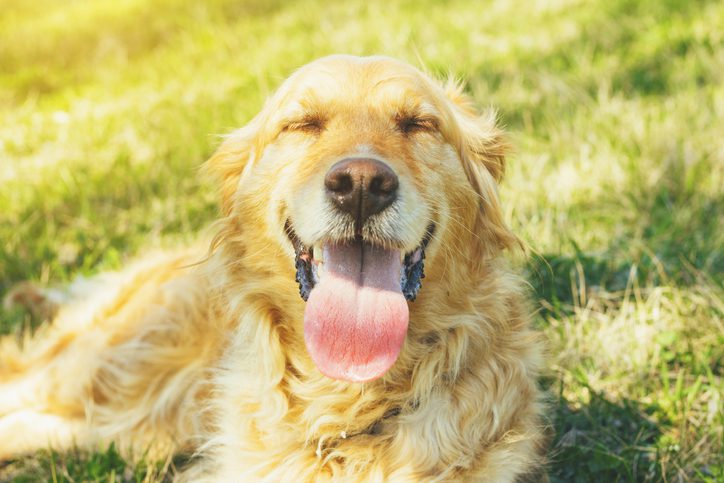Dogs that get heatstroke need immediate medical attention. Dog owners need to know the symptoms of heatstroke so that they can be sure that their dog gets help if they have gotten overheated. It is much easier than you might think for your dog to get heatstroke, and many people are not aware that dogs struggle to stay cool when it’s warm out.
Knowing how to protect your dog from heatstroke is key. This is especially true if you like to take your dog on hikes or out to the dog park every day. You need to know what heatstroke is and how to protect your pet so that you can avoid this medical emergency. Many people think that dogs are quite good at cooling off so long as they are in the shade or have access to some water while exerting, but this is not actually the case.

What is Dog Heatstroke?
Dog heatstroke happens when a dog’s body temperature gets too high for them to stay healthy. A normal dog’s temperature should be between 100 and 102.2. If your dog’s temperature gets any higher than this, they can get very sick and even suffer organ damage. Dogs are only able to cool themselves by panting and by sweating through the pads of their feet. If they are not able to drink enough water and are exposed to high temperatures or exert too much in warm weather, they can get heatstroke.
Heatstroke can become life-threatening within half an hour. Dogs that are not given treatment at this point usually suffer organ damage that cannot be reversed. Even a mild heatstroke can cause lasting health issues for pets.
Symptoms of Heatstroke in Dogs
Symptoms of dog heatstroke can include any of the following:
- Excessive panting
- Vomiting
- Diarrhea
- Disorientation
- Weakness or collapse
- Seizures
- Increased heart rate
- High temperature
If your pet is showing these symptoms, give your veterinarian a call right away.
How to Protect Your Pet from Heatstroke
Knowing how to protect your dog from heatstroke matters. Even if your dog is older and doesn’t spend much time outside, you still should know the symptoms of this condition. Dogs do not have to be exerting outside to get too hot and suffer from heatstroke. Standing on hot pavement can be enough to give a dog heatstroke.
Test the Temperature of the Pavement
If it is warmer than 75 degrees outside and you are planning to take your dog for a walk or a run, you might be exposing them to the risk of heatstroke. You should always test the temperature of the pavement with your hand before you take your dog running in the summer. If you cannot tolerate having your hand on the pavement, your dog’s feet will not be comfortable on the sidewalk or the road either.
Provide Access to Water
Always make sure that your dog has access to plenty of fresh and clean water, no matter how cold or hot it gets. You will also want to be sure that you don’t leave your pet outside in the summer without shade. If the temperature is about 80 degrees, your dog should not spend more than a short time in the yard.
Consider the Temperature and Activity
While it can be fun to take your dog camping, hunting, walking, or running in the summer, in many cases, it will be far too hot for your pet. The same goes for keeping your dog in the car when it’s hot out. Pets locked in the car in the heat are at risk of getting heatstroke in minutes.
What to Do if Your Dog Might Have Heatstroke
If your dog could have heatstroke be sure to communicate this with your vet and follow any intrusions they provide for your pet’s care.
Call Your Veterinarian
If you think that your dog has heatstroke, you need to be sure that you call your veterinarian right away. They might want you to stabilize your dog before you come in or they might want you to head to the animal hospital immediately. You should never use very cold water to cool your dog down so that you don’t shock their system. Apply cool water to their body but never use very cold water.
Take Your Dog to the Vet
The vet will usually rush your dog to the back of the clinic for treatment. IV fluids will usually be given to your pet, and they will also typically be given electrolytes to help protect their organs from damage. Pets might need to be kept at the vet for observation for a few days to be sure that they are going to stabilize.
Consider Your Dog’s Breed and Needs
If your pet is a pug or one of the other breeds that are brachycephalic, or if your dog is obese, they might be more at risk for complications related to heatstroke. These dogs should never be exposed to heat under any conditions. These dogs should only go outside for short bathroom breaks when it’s hot to protect them from heatstroke. Even if you don’t have air conditioning, the temperature in your home will be much more ideal for this kind of dog than the yard.
Protecting Your Dog from Heatstroke is Important
No matter what breed of dog you own or how old your dog is, you need to be sure that you are not exposing them to the heat for prolonged periods of time. Dogs can be very susceptible to warm temperatures due to how hard it is for them to cool off. Make sure that you are familiar with the symptoms of heatstroke so that you recognize the signs before it’s too late. Dogs have half an hour to get treatment for heatstroke before it’s too late to save them in most cases.
Dog heatstroke is usually easy to avoid. You should keep your pet indoors when it is hotter than 75 degrees out. Always make sure that your dog has access to enough water as well, no matter what season it is or how hot or cold it is. Keep pets inside during the summer and make sure that they are in a place with enough air circulation. Your dog should never be left in the car when it’s hot out, either. Dogs will fare the best in the hot months of the year if they stay inside where it is cool and there is enough water to drink.
If you have questions about your dog’s care, be sure to call Northern Pike Veterinary Hospital at 412-373-8580!

